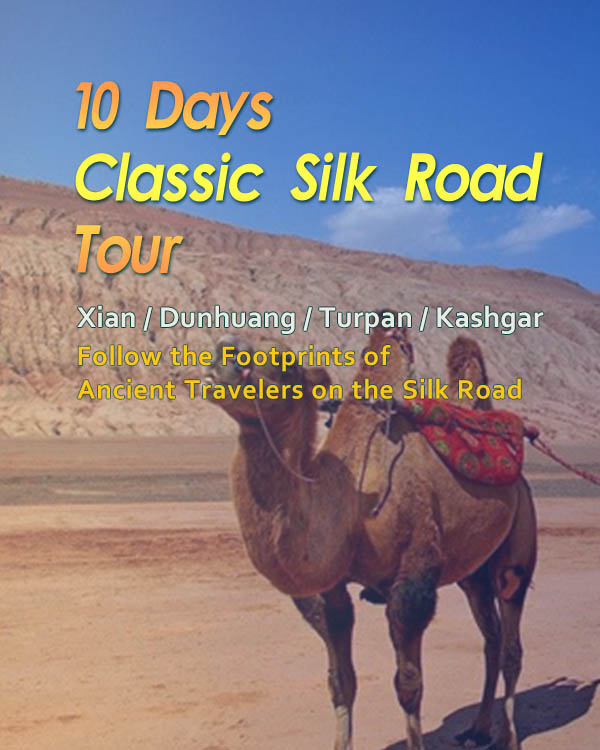Silk Road History | Silk Routes in China's Different Periods & Empires
China Silk Road History
Silk Road, or called Silk Route, Silu in Chinese, is a series of ancient trade routes connecting China with the middle, west, south and east Asia, European and North Africa. Silk Road nowadays we talk about commonly refers to the Land Silk Road, which started from the ancient capital of China in the Western Han Dynasty (202 BC~8 AD)- Chang’an (today’s Xian), through Northwest China’s Gansu and Xinjiang to the Central, West Asia and reached the Mediterranean countries. Along with peculiar goods trades, like outbound silks, porcelains, inbound spices, jewelry between China and other countries, cultures, arts, techniques and religions from different countries encountered and interacted on the Silk Road, prompting significant political, economic and cultural exchanges. Ancient Silk Road is not in use today, but more known as a mysterious travel route with numerous historical and cultural heritages and multi-culture. Let’s travel back to ancient China to find out when and why the Silk Road started, how it evolved and declined. Hopefully, the introduction here gives you a clear and detailed insight into Silk Road history, spirit and culture and helps you better plan an adventure to the Silk Road regions of China.
China Silk Road History in Different Periods and Empires
The ancient Silk Road has experienced several important stages since it was originally opened in the Western Han Dynasty and ended in the Qing Dynasty. And, it played different roles in different dynasties. Follow the timeline to check the complete history of the Silk Road’s beginning, flourishing and fading.
1. Ambassador Zhang Qian’s Visits to the Western Regions in the Western Han Dynasty - the Origin of Silk Road

Zhang Qian Visited the Western Regions in the Western Han Dynasty
Why did the Silk Road begin?
Areas in the west of Yangguan Pass and Yumen Pass, including Xinjiang, were called the Western Regions during the Western Han Dynasty.
From the beginning of the establishment of the Western Han Dynasty, the northwest regions of the country had always been harassed by the northern nomadic tribe - Xiongnu. To make military alliance with the Yuzi against Xiongnu and expand the market, in 139 BC, Emperor Wu of the Western Han Dynasty dispatched Zhang Qian, an official as a diplomat with a mission from Chang’an to the Western Regions. Unfortunately, Zhang Qian and his diplomatic corps were caught in the Hexi Corrider. The Xiongnu leader didn’t kill him, but made Zhang Qian married a Xiongnu wife and detained him in the remote western area for over 10 years. Later, Zhang Qian got a chance and successfully escaped with his only surviving accompany and his Xiongnu wife and child. He never forgot his mission and continued his adventure to the Western Regions. With the kind treatment and help from the Dayuan, Zhang Qian finally arrived at Yuezhi. But the king of Yuezhi was not interested in revenge against Xiongnu and alliance with the Western Han Dynasty. After staying in Yuezhi and persuading for more than 1 year, Zhang Qian had to return but again got arrested by Xiongnu for another year. He ran back to Chang’an when civil strife broke out in Xiongnu. Though Zhangqian’s first visit didn’t achieve the mission, his 13-year experience offered a helpful perception of customs and cultures of the Western Regions’ countries, which laid a foundation for the opening of Silk Road.
Many years later (in 119 BC), Zhang Qian made a second journey to the Western Regions with more envoys and goods. On the one hand, he tried hard to establish an alliance with Wusun - another foe of Xiongnu and finally succeeded. On the other hand, Zhang Qian sent deputy envoys to Dayuan, Yutian, Kangyu, Yuezhi, Daxia (today’s northern Afghanistan), Anxi (Iran today), Shendu (India) and other surrounding small countries. The second contact was accomplished. The path Zhang Qian walked is the original route of the world-famous Silk Road. Thanks to Zhang Qian’s two-time brave adventures and Emperor Wu’s political ambition and economic foresight, talking to the Western Regions and farther areas became possible and smooth and influential. The Silk Road promoted cultural fusion of the east and the west, and Buddhism was hence transmitted into China via the ancient Silk Road during this period.
After Wang Mang usurped power in the late Western Han Dynasty, countries in the Western Regions were ruled by the Xiongnu, and cut off communication with the new regime. The Silk Road was thus forced to halt.
Popular Silk Road Tours including Xian:
2. Ban Chao’s Management of the Western Regions in the Eastern Han Dynasty

Statue of Ban Chao near the Overhang Great Wall, Jiayuguan, Gansu ©活到天年 / meipian
In the Eastern Han Dynasty (73 AD), Ban Chao, a notable militarist and diplomat, was ordered to visit the Western Regions with a senior general who fought against the Xiongnu. He firstly subdued the Shanshan Kingdom, and soon successfully convinced Yutian and totally over 50 Kingdoms to pledge allegiance to the Eastern Han Dynasty. After helping countries in the Western Regions get rid of Xiongnu’s control, Ban Chao was assigned as the protectorate of the Western Regions to manage the areas. The Silk Road, which had been cut down for 58 years, therefore reopened again. In the following years, Ban Chao sent envoys to Daqin (Roman Empire) and Tiaozhi Sea (today’s Persian Gulf), and Daqin sent back emissaries to Luoyang, capital of the Eastern Han Dynasty. The territory expansion, reopening and farther reaching of Silk Road were credited to Ban Chao, his distinguished talent and 30-year management in the Western Regions. China's first Buddhist temple - White Horse Temple was built in Luoyang in 68 AD of the Eastern Han Dynasty.
Popular Silk Road Tours including Luoyang:
3. China Silk Road in the Wei & Jin Dynasties
Silk Road continued to develop during the Wei and Jin Dynasties (220 AD ~ 420 AD). Persia (the old name of Iran) made frequent communication with the Northern Wei Dynasty. Nearly 10 diplomatic corps were sent to ancient capitals at that time - Datong and Luoyang. Glass making craft was brought to China consequently. In 518 AD of the Northern Wei Dynasty, Song Yun and monk Hui Sheng, Fa Li departed from Luoyang, via Tuguhun, Shanshan, Zuomo (today Xinjiang’s Qiemo), Han, Yutian to the Western Regions, and traveled across Persia and other Asian countries to India. In 522, they returned to Luoyang with 170 Mahayana sutras. Ambassadors of Persia also traveled to ancient China via the Silk Road, and presented rare Buddha tooth relic and many other treasures to the court. The contacts and exchanges greatly enriched the Buddhist and ritual culture of China, and promoted the exchange of economic trade and production technology between ancient China and other countries.
4. China Silk Road in the Sui Dynasty
During the early Sui Dynasty, the rising Tujue (Turks) occupied large areas of the Western Regions. As a result, trade and communication between the Central Plains and Western Regions was hindered. However, the Sui Dynasty later developed a close relationship between the countries in the Western Regions, and many merchants made trades in Zhangye. Emperor Yang of the Sui Dynasty even sent Pei Ju, a famed politician, diplomat and geographer, to Zhangye to supervise frontier trades in the Western Regions. Pei Ju further promoted commodity circulation and cultural exchange. He recorded the landscape, products, costumes and customs of 44 countries in the Western Regions in his book - the Maps of and Notes About the Western Regions 《西域图记》, which made a significant contribution to the territory expansion and ethnic fusion of the Sui Dynasty.
Popular Silk Road Tours including Zhangye:
5. China Silk Road in the Tang Dynasty - Great Prosperity

Silk Road Map in the Tang Dynasty Exhibited in Ningxia's Guyuan Museum ©llsboc / qunar
The Silk Road stepped into the most thriving and prosperous stage in the Tang Dynasty (618 AD ~ 907 AD), when China was the richest and most powerful country in the world. Emperor Taizong and Gaozong defeated the Eastern and Western Turks successively and established special organizations to manage the areas. The Tang Dynasty by this time had all-sides and friendly contacts with the Arab Empire through the Silk Road.
In the Tang Dynasty, many branches were built in the east section of the Silk Road for worshipping Emperor Taizong who got the title of “Tengeri Qaghan”. The Arab Empire and the Eastern Roman Empire both dispatched envoys to Chang’an (Xian) to make intercourse with China. Dunhuang, Yangguan Pass, Yumen Pass served as busy trade centers. Besides, the Tang Dynasty made long-range voyages to today’s Vietnam, Cambodia, Burma, India, Jave and all the way to the Arab Empire, and tried deeper contact with the western nations. Guangzhou, Quanzhou (in Fujian) and some coastal cities were the busiest ports in those days.
Buddhism reached its peak during the Tang Dynasty based on open and prosperous conduct. During the period of Emperor Taizong, Tang Sanzang, a famous hierarch, traveled along the Silk Road to the Central Asia and India to seek Buddhist sutras. After a 16-year journey, he brought 657 Buddhist scriptures back to the Tang Dynasty and wrote a book - Journey to the West to record the societies and folk customs in India and countries along the Silk Road. Emperor Gaozong specially constructed the Giant Wild Goose Pagoda in Chang’an (Xian) to let him store and translate the Sutras. Another eminent monk - Yi Jing, made a voyage to India for 16 years and also carried hundreds of important Buddhist Sutras, which introduces the culture and life of the South Asian countries.
Just because of the strong national power and open mind of the Tang Dynasty, Silk Road was very smooth and booming, further promoted ideological and cultural exchanges between the East and the West and had lots of profound and positive influences. Many things were introduced between China and the western countries, such as the religion of the Eastern Roman Empire, China’s paper-making, medicine, crops and fruits, dances, music from the west, etc.
Popular Silk Road Tours including Xian:
6.China Silk Road in the Song & Yuan Dynasties - the Fall of Silk Road & Rise of Maritime Silk Road
The national power of the Song Dynasty (960 AD ~ 1279 AD) fell off since the 10th century. Hence, Hexi Corridor gradually got out of control, soon the northwestern regions. After the brave and powerful Mongols established the Yuan Dynasty (1271 AD ~ 1368 AD), they made several military expeditions and campaigns to the west and south regions, largely expanding the territory. They established many posthouses and resumed communication between Europe and Asia, so the trade and Silk Road once again flourished. Countless merchants from Europe, Central and West Asia brought gold, silver, jewelry, spices to China and sold them on the way, and they usually bought silks, tea, porcelains and medicine materials from China. The bustling trade caravan and metropolis prosperity had been described in Marco Polo’s book - the Travels of Marco Polo.
7. Silk Road in the Ming & Qing Dynasties - Decline of Ancient Silk Road

Landscape Map of the Silk Road © minghuaji
The Silk Road during the Ming Dynasty was drawn on a 30.12-meter long, 0.59-meter-wide silk scroll painting - Landscape Map of the Silk Road 《丝路山水地图》. The painting was a remarkable cultural relic from the middle Ming Dynasty and it clearly marks over 200 cities along the Silk Road, such as Dunhuang, Turpan and Hami (China), Samarkand (Uzbekistan), Damascus (Syria). It helps us know the detailed Silk Road route - from China’s Jiayuguan to Saudi Arabia’s Mecca and spectacular cities and land in the Ming Dynasty. The painting has been donated to the Palace Museum (Forbidden City) in Beijing to let the public learn more about the authentic history of the Silk Road.
Maritime Silk Road entered its heyday in the Ming Dynasty. The most famous feat belongs to Zheng He’s 7-time sea adventures to the Western Pacific and Indian Ocean with the largest scale, the largest ships, seamen and longest duration in Chinese history. He and his fleet had visited more than 30 countries in the South Asia and East Africa, expanded overseas trade, affected home industry, created impactful contribution to cultural exchange and geographical exploration. Guangzhou, Quanzhou and Ningbo are the three major ports of the Maritime Silk Road of the Ming Dynasty. On July 25, 2021, “Quanzhou: Emporium of the World in Song-Yuan China” in Quanzhou, Fujian Province was listed as a new UNESCO World Cultural Heritage for the complex completely shows the successful overseas trade of ancient China and witnessed the extraordinary maritime trade prosperity during the 10-14th century. To protect the peace and stability of the southeast coastal areas of China, the officials in the Ming and Qing Dynasties carried out isolation policy and bans of maritime affairs, which unfortunately cut off both the land and maritime Silk Road and contacts with the outside world.
Popular Silk Road Tours including Gansu & Xinjiang:
How to Plan a China Silk Road Travel
Major Destinations to Go: Xian, Luoyang, Dunhuang, Zhangye, Jiayuguan, Lanzhou, Qinghai, Urumqi, Turpan, Kashgar, Kucha, Hotan, Tianshui, Ningxia...
Top Tourist Attractions to Visit: Xian Terracotta Warriors, Dunhuang Mogao Caves, Zhangye Danxia Landform - Rainbow Mountains, Qinghai Lake, Heavenly Lake, Jiaohe Ancient City, Kashgar Old Town, Karakul Lake...
Best Time to Go: Generally, months from April to October are the best time, because the temperature is moderate and pleasant, the weather is good and the natural scenery is the most beautiful during this period.
The ancient Silk Road is a long tourist travel route involving lots of Chinese destinations, mostly located in Northwest China. A Silk Road travel can be flexibly customized according to travelers’ length of vacations, departure city, individual preferences and budget. It can take a few days to a few weeks and months.
If you have a tight schedule with only several days (4 ~ 5 days), you’re advised to make a brief Silk Road tour from the starting point - Xian, and visit Luoyang nearby or Dunhuang, the legendary treasury of Buddhist art, history and culture. If you have visited Xian and would like a deeper exploration, then Gansu’s Hexi Corridor (Zhangye, Jiayuguan and Dunhuang) - essence of ancient Silk Road is the best recommendation and a classic trip takes about 6 days.
☛ 6 Days Zhangye Jiayuguan Dunhuang Discovery Tour
☛ 5 Days Silk Road Tour from Xian to Dunhuang by Flight
☛ 5 Days Luoyang Xian Tour by Train
Travelers with 7 ~ 8 days can visit more Silk Road destinations. You can explore the Hexi Corridor with neighboring Qinghai, enjoy beautiful Qinghai Lake and other stunning landscapes and cultures, or travel farther to Xinjiang, unveil the mysterious Western Regions in top destinations - Turpan, Urumqi and Kashgar. Depending on your pace, you can even take some side trips, such as travelling to Karakul Lake from Kashgar.
☛ 7 Days Miraculous Land Tour from Dunhuang to Zhangye Xining
☛ 8 Days Classic Xinjiang Tour including Urumqi Turpan Kashgar Tashkurgan
A holiday of 10 ~ 15 days and a longer length is suitable to cover major destinations along the Silk Road in China. You can flexibly arrange an itinerary based on your interests. The most classic Silk Road tour covers Xian, main destinations in Hexi Corridor and Xinjiang, and takes just 10 days. Qinghai and Ningxia are popular regions for an in-depth Silk Road adventure. If time allows, you can visit the holy land of Tibet (Lhasa, Shigatse, Mount Everest, Mt.Kailash...) which has impressive Buddhist and Tibetan culture and plateau vista, and other destinations in China to experience the vast and diversity of China.
☛ 10 Days Classic Silk Road Tour (Xian/Dunhuang/Turpan/Kashgar)
☛ 11 Days In-depth Wild Silk Road Adventure Tour
☛ 12 Days Epic Silk Road Tour including Qinghai Lake and Zhangye Danxia
☛ 15 Days Classic Ancient China Silk Road Tour with Bullet Train Experience
☛ 19 Days Silk Road & Tibet In-depth Tour
 Our customers Cameron Family from New Zealand visited Terracotta Warriors in Xian in July, 2021.
Our customers Cameron Family from New Zealand visited Terracotta Warriors in Xian in July, 2021.
 Our customers Erin family from USA visited Zhangye Danxia Geopark in Gansu in August, 2020.
Our customers Erin family from USA visited Zhangye Danxia Geopark in Gansu in August, 2020.
 Kashgar Old Town ©骆小洛的世界 / mafengwo
Kashgar Old Town ©骆小洛的世界 / mafengwo
Travel to Silk Road with China Discovery
Since most destinations along the ancient Silk Road are located in the remote Northwest China and some attractions are scattered far from the cities, it’s best to travel with a local professional travel agency, like China Discovery, to enjoy a Silk Road adventure. We will not only help you plan a suitable travel itinerary, but also arrange all the services you need, including tour guides and drivers, transfer vehicles, hotels and tickets, meals, etc., to make sure you make an educational cultural and historical travel with relaxing visual enjoyment. You can find more inspiration from our Most Popular China Silk Road Tours or contact us to customize a special one.
- Popular China Silk Road Tours
- How to Plan a Silk Road Travel
- Popular Xian Tours
- Popular Luoyang Tours
- Popular Gansu Tours - Dunhuang...
- Popular Qinghai Tours - Xining...
- Popular Xinjiang Tours - Kashgar...
- Customize China Silk Road Tour
China Silk Road Tours:
- Major Silk Road Cities & Destinations
- Top Silk Road Tourist Attractions
- Xian Travel Guide
- Luoyang Travel Guide
- Dunhuang Travel Guide
- Zhangye Travel Guide
- Jiayuguan Travel Guide
- Qinghai Travel Guide
- Xinjiang Travel Guide
- Silk Road Facts
- China Silk Road Routes
- China Silk Road Accommodation
- Useful Silk Road Maps
- China Silk Road Travel Tips











































